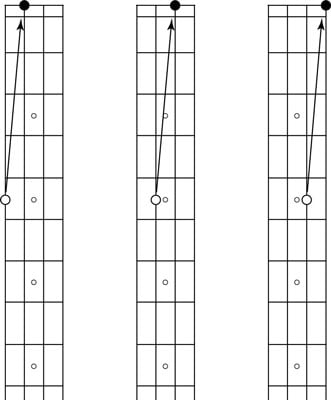The 5th-fret tuning method is the most common method for tuning bass guitars. If you're playing with other people, be sure to get a reference pitch for the E string (the lowest and thickest string) from one of the other tuned instruments, and then tune that string before tuning the others.
The following steps explain how to tune your bass by using the 5th-fret method:
Using one of the fingers on your left hand, press the tuned E string down at the 5th fret.
Touch only the E string, because the open A string needs to vibrate freely. The place to press is actually between the 4th and 5th frets, slightly behind the 5th fret.
Strike the fretted E and the open A strings together with your right-hand index finger and let them ring.
While you're comparing the sounds of the two strings, keep your left-hand finger holding down the lower string at the 5th fret. Get used to turning your tuning heads with your right hand (by reaching over your left hand) when using this method. The notes should be a perfect match. If they're not (which is usually the case), follow these steps:
Listen to whether the sound of the A string is lower (flat) or higher (sharp) than the E string.
You hear a wavering sound if the strings aren't in tune.
If you're not sure whether the A string is sharp or flat, lower the pitch of the A string until you can hear that it's clearly flat.
Restrike both strings, and then slowly raise the pitch of the A string by turning its tuning head with your right hand until the sound matches the pitch of the E string at the 5th fret.
If you go too far, you can hear that the A string is sharp (too high). In that case, lower the pitch of the A string by turning its tuning head in the other direction. When the A string is in tune with the E string, you're ready to tune the D string.
Press the tuned A string down at the 5th fret (touching only the A string).
Strike the A and open D strings together and let them ring.
Listen to whether the D string is sharp or flat, and then turn the tuning head for the D string accordingly until the pitch of both strings matches perfectly. When the D string is in tune with the 5th fret of the A string, proceed to tuning the G string.
Press the tuned D string down at the 5th fret (touching only the D string).
Strike the D and open G strings together and let them ring.
Listen to whether the G string is sharp or flat, and then turn the tuning head for the G string accordingly until the pitch of the 5th fret of the D string matches the open G string perfectly.
Your bass is now in tune. If you tuned the E string to a reference pitch, you're now ready to play with anybody who's in tune with that same reference pitch.


